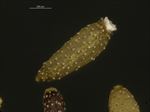Taxonomy
Euchiton sphaericus (Willd.) Holub., New names inPhanerogamae 3. Folia Geobotanica et Phytotaxonomica 9(3): 261-275. 1974Common synonyms
Euchiton sphaericus (Willd.) Anderb.; Gnaphalium hemisphaericum Hornem.; Gnaphalium involucratum var. simplex DC.; Gnaphalium morii Hayata; Gnaphalium sphaericum Willd.; Leontopodium japonicum var. sandwicense H.Lév.
Common name
Tropical Creeping Cudweed
Description
Propagule or dispersal unit is the fruit with pappus. Fertile part 0.6-0.8 mm long, 0.2-0.4 mm wide, in side view widest in upper part (obovoid), +/- straight, the upper (apical) end narrowing, in cross-section flattened, central, rarely off to the side (oblique) or at least asymmetric, beak (=thinner sterile stalk between seed and pappus) absent, wings absent, fruit surface light brown or straw, smooth (except at cellular level), with glands or glandular hairs or papillae (small protuberances) (?), thickened margin absent, longitudinal ribs absent or present, 3-6, their surfaces smooth, with glands or glandular hairs or papillae (small protuberances) (?).
Pappus type bristles / hairs, pappus elements all +/- similar, up to 2-3 mm long, in one row, pappus elements numerous, falling off as a whole or elements falling off individually, the individual bristles rough / serrated (barbellate), +/- equal width along length, white / translucent.
Ecology
Annual herb, seeds wind-dispersed. Temperate to tropical areas. Found in various disturbed habitats, including urban areas.
Native range
Australia, New Zealand, New Caledonia, Taiwan, Java, Philippines, and Papua New Guinea
Introduced range
Hawai’i, California, Oregon.
Weed status within Australia
native








